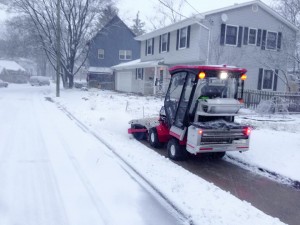With many of Michigan’s communities recovering from our coldest or snowiest Februaries on record, the Water Hill neighborhood in Ann Arbor is making headlines from The Atlantic’s CityLab to the Christian Science Monitor with “SnowBuddy.” From their webpage:
SnowBuddy is a unique nonprofit sidewalk snow removal service run like a public radio station. It provides its service for free to an entire area and is supported by donations.
Instead of dividing walkways into segments assigned to property owners, SnowBuddy sees the sidewalk as a continuous right-of-way, a transportation corridor most appropriately maintained in its entirety, using municipal-quality equipment, as a service to the community.

SnowBuddy’s tractor can clear the sidewalk in front of a residential lot in approximately 10 seconds. Photo courtesy Paul Tinkerhess.
After last year’s heavy snows, neighbors raised over $20,000 to put a down payment on a sidewalk tractor with brush and plow attachments, buy fuel, ice melt, and insurance, and train a team of volunteer drivers. After each snow, SnowBuddy clears 12 miles of sidewalk throughout the neighborhood, as well as clearing the major walking routes to downtown Ann Arbor. (Another team of volunteers, the “windrow patrol,” hand-shovels the sidewalk curb ramps at intersections where they’ve been buried by the city’s snow plows.)
The project is a testament to Water Hill’s neighborly sense of place (see also their annual music festival, held on dozens of front porches each May), but it also poses a serious question: if we want walking and biking to be real transportation choices in our communities, can we reasonably leave sidewalk snow removal to individual property owners?
Dozens of Michigan communities have formally adopted Complete Streets ordinances or policies, recognizing that thriving downtowns and attractive urban neighborhoods require infrastructure that serves residents’ varied transportation needs, from car, bus, and delivery truck to bicycle and pedestrian. As SnowBuddy’s organizers point out, though, few of these Complete Streets policies extend beyond the construction of the infrastructure to its maintenance. Transportation only works as a network: a 40-foot long stretch of ice where a single property owner has failed to clear their sidewalk makes a pedestrian’s commute dangerous, no matter how diligent the rest of the neighbors on the block.
Why is it that most communities consider street plowing among the most fundamental of public services, but leave sidewalks snow removal in the hands of individual property owners? If we continue to have winters like this year’s and last, we may need better answers to that question as we strive to build attractive, quality places.